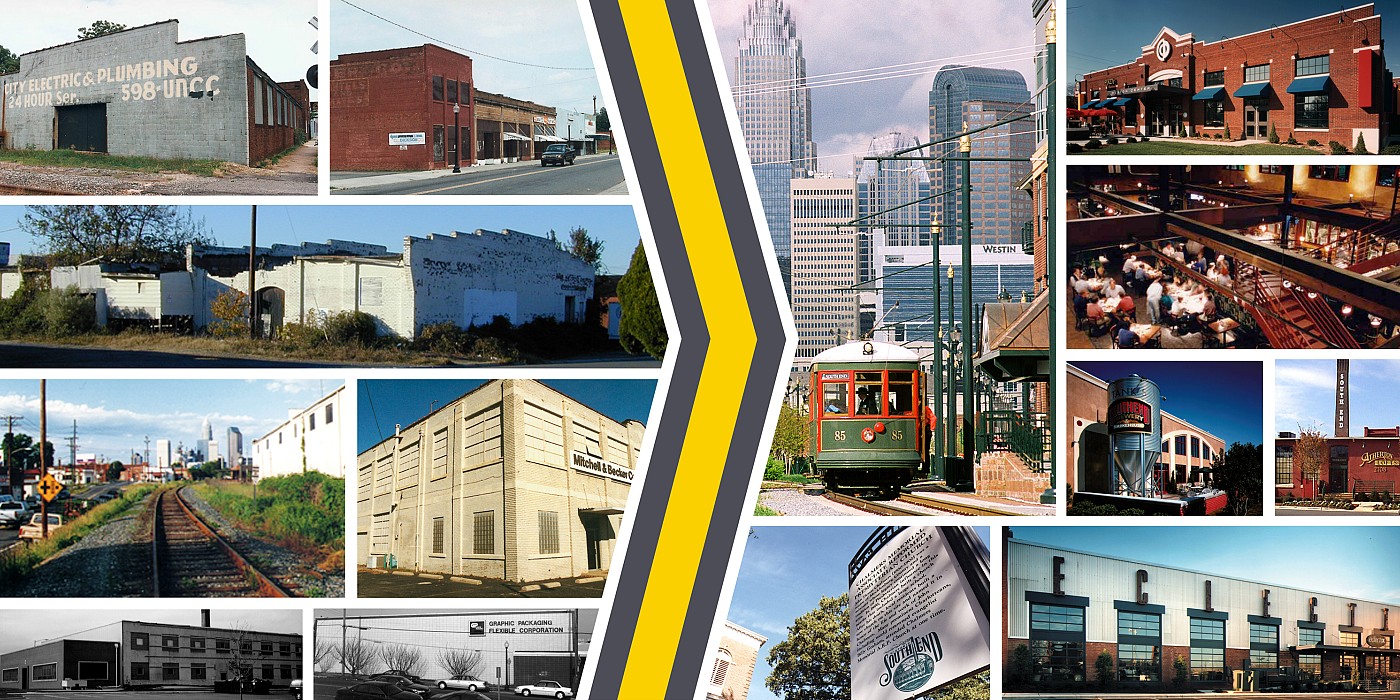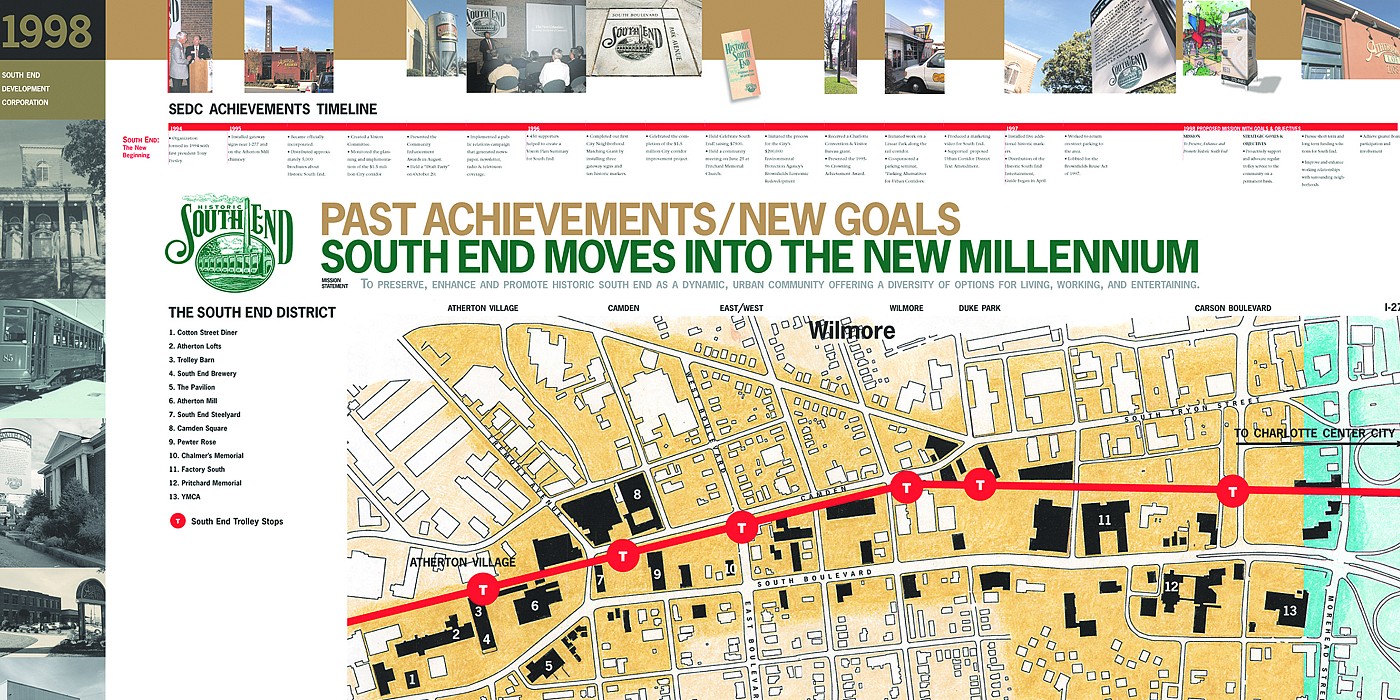- You have not saved any projects.
Historic South End
Over the course of a thirty-five year span, Shook Kelley and its founders have worked as both community volunteers and consultants on many initiatives in support of downtown Charlotte's Business Improvement Districts, including one that we advocated, established and initially managed: South End.






Shook Kelley has been widely recognized for creating a vision and being the brand author of South End, an area that was, in the 80s and early 90s, universally described as “blighted”—a largely abandoned rail corridor, with overgrown lots, containing old warehouse buildings that were dilapidated, underutilized or vacant.
The district’s close proximity to burgeoning Center City Charlotte and to prominent neighborhoods made the area an opportunity for rebirth, and for celebrating a piece of Charlotte’s history. Shook Kelley led an effort to brand and plan this warehouse area as Charlotte’s Next Great Neighborhood—by preserving, enhancing and promoting South End as a dynamic, urban community offering a diversity of options for living, working, and entertaining—including the development of a vision for Charlotte Trolley– a project that has been credited with initially spurring more than $500 million worth of development, and in birthing what is now Charlotte's first light rail transit corridor, the LYNX Blue Line.
A big challenge in creating the brand of South End was to convince businesses to invest in the area and locate there at the outset. The fact that property values were low helped attract small start-up businesses and unique retailers, but with no assets or revenue to begin with, creating South End was much like building a start-up company. The goal was to appeal to a demographic that craved an urban experience that was unique and eclectic—something Charlotte was missing. South End was characterized by icons of the past: red brick industrial buildings, pedestrian friendly streetscapes and the Charlotte Trolley, so the brand was built around a notion of preserving history while making it new, fresh and accessible.
Shook Kelley—whose Charlotte office location is in the very heart of South End—along with a small handful of other community citizens, decided to create and form a community organization for the betterment of this underutilized area that was known only then as the South Boulevard Corridor. One of the first things Shook Kelley did was to create a new brand name and logo for the area, setting about the pivotal process of rebranding the area as “South End.”
Historic South End has evolved into one the most dynamic and desirable places in Charlotte as a vibrant, successful live/work destination
What followed that name and logo were many initiatives and efforts in subsequent years led by Shook Kelley, a few key items being: The establishment of a physical town hall and public forum—called the Powerhouse— for promoting and encouraging public participation for the district; the development of key visible brand points throughout the area; the transformation of a then negative, symbolic rail corridor into a vision for a lively trolley system, and; the creation of a permanent funding mechanism for the district passed by the Charlotte City Council (Business Improvement District) that is still in effect today. Shook Kelley continues to be involved with present-day planning initiatives, assisting both public and private interests to add and enhance the experience that is South End. To view the current iniative for the Rail Trail, click here.
Through these key initiatives for South End, Shook Kelley, along with other community and business leaders were able to demonstrate, develop and perfect place branding theories for how urban districts can overcome apathy, blight and decay and become viable, healthy communities. As a result of these efforts that consciously convened many people and entities, South End is the most important grassroots undertaking in the history of Charlotte. The community of South End has seen property values increase by as much as 500% since the first businesses relocated to the area. The success of the revitalized trolley helped gain support for Charlotte's first light rail corridor—The LYNX Blue line—which opened in late 2007, and continues to exceed ridership projections.
Some 20-odd and relatively short years later, South End is a district that will soon be home to over 8,000 people living in multiple new urban apartment and mixed-use projects, scores of others working in creative and other businesses, and with an entire region convening for shopping, dining or to experience the vitality of a great, urban place.
Shook Kelley has been widely recognized for creating a vision and being the brand author of South End, an area that was, in the 80s and early 90s, universally described as “blighted”—a largely abandoned rail corridor, with overgrown lots, containing old warehouse buildings that were dilapidated, underutilized or vacant.
The district’s close proximity to burgeoning Center City Charlotte and to prominent neighborhoods made the area an opportunity for rebirth, and for celebrating a piece of Charlotte’s history. Shook Kelley led an effort to brand and plan this warehouse area as Charlotte’s Next Great Neighborhood—by preserving, enhancing and promoting South End as a dynamic, urban community offering a diversity of options for living, working, and entertaining—including the development of a vision for Charlotte Trolley– a project that has been credited with initially spurring more than $500 million worth of development, and in birthing what is now Charlotte's first light rail transit corridor, the LYNX Blue Line.
A big challenge in creating the brand of South End was to convince businesses to invest in the area and locate there at the outset. The fact that property values were low helped attract small start-up businesses and unique retailers, but with no assets or revenue to begin with, creating South End was much like building a start-up company. The goal was to appeal to a demographic that craved an urban experience that was unique and eclectic—something Charlotte was missing. South End was characterized by icons of the past: red brick industrial buildings, pedestrian friendly streetscapes and the Charlotte Trolley, so the brand was built around a notion of preserving history while making it new, fresh and accessible.
Shook Kelley—whose Charlotte office location is in the very heart of South End—along with a small handful of other community citizens, decided to create and form a community organization for the betterment of this underutilized area that was known only then as the South Boulevard Corridor. One of the first things Shook Kelley did was to create a new brand name and logo for the area, setting about the pivotal process of rebranding the area as “South End.”
Historic South End has evolved into one the most dynamic and desirable places in Charlotte as a vibrant, successful live/work destination
What followed that name and logo were many initiatives and efforts in subsequent years led by Shook Kelley, a few key items being: The establishment of a physical town hall and public forum—called the Powerhouse— for promoting and encouraging public participation for the district; the development of key visible brand points throughout the area; the transformation of a then negative, symbolic rail corridor into a vision for a lively trolley system, and; the creation of a permanent funding mechanism for the district passed by the Charlotte City Council (Business Improvement District) that is still in effect today. Shook Kelley continues to be involved with present-day planning initiatives, assisting both public and private interests to add and enhance the experience that is South End. To view the current iniative for the Rail Trail, click here.
Through these key initiatives for South End, Shook Kelley, along with other community and business leaders were able to demonstrate, develop and perfect place branding theories for how urban districts can overcome apathy, blight and decay and become viable, healthy communities. As a result of these efforts that consciously convened many people and entities, South End is the most important grassroots undertaking in the history of Charlotte. The community of South End has seen property values increase by as much as 500% since the first businesses relocated to the area. The success of the revitalized trolley helped gain support for Charlotte's first light rail corridor—The LYNX Blue line—which opened in late 2007, and continues to exceed ridership projections.
Some 20-odd and relatively short years later, South End is a district that will soon be home to over 8,000 people living in multiple new urban apartment and mixed-use projects, scores of others working in creative and other businesses, and with an entire region convening for shopping, dining or to experience the vitality of a great, urban place.